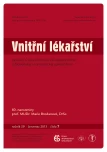Hepatic cein catheterisation – selected assessment aspects
Authors:
J. Petrtýl 1; R. Brůha 1; P. Urbánek 2; Z. Mareček 3; M. Kaláb 1
Published in:
Vnitř Lék 2013; 59(7): 587-590
Category:
Overview
Introduction:
Hepatic vein catheterisation and portal hypertension assessment using the value of portal hepatic gradient (HVPG) is currently a method of choice.
Methodology:
In our paper we shall compare HVPG with the so‑ called direct gradient – using the difference in pressure in the portal vein and free hepatic vein in 5 groups of patients with liver cirrhosis.
Results:
Hepatic vein catheterisation is reliable for assessing the portal hypertension in the group of patients with liver cirrhosis of ethylic etiology. In patients with liver cirrhosis resulting from hepatitis B, Wilson’s disease or primary biliary cirrhosis, a statistically significant difference between HVPG and the direct gradient has been found. In patients with liver cirrhosis resulting from hepatitis C the obtained values differed but without statistical significance.
Conclusion:
In catheterisation of hepatic veins the HVPG value in liver cirrhosis with a presinusoidal component may be reduced, which has to be primarily taken into account when assessing the relationship to some critical values of the portal hepatic gradient.
Key words:
portal hypertension – hepatic vein catheterisation – liver cirrhosis – portal hepatic gradient
Sources
1. Bosch J, García‑ Pagán JC. Complication of cirrhosis. I. Portal hypertension. J Hepatol 2000; 32 (Suppl 1): 141– 156.
2. van Leeuwen DJ, Howe SC, Scheuer PJ et al. Portal hypertesion in chronic hepatitis: relationship to morphological changes. Gut 1990; 31: 339– 343.
3. de Franchis R. Updating consensus in portal hypertension: report of the Baveno III Consensus Workshop on definitions, methodology and therapeutic strategies in portal hypertension. J Hepatol 2000; 33: 846– 852.
4. Garcia‑ Tsao G, Groszmann RJ, Fisher RL et al. Portal pressure, presence of gastroesophageal varices and variceal bleeding. Hepatology 1985; 5: 419– 424.
5. Feu F, García‑ Pagán JC, Bosch J et al. Relation between portal pressure response to pharmacotherapy and risk of recurrent variceal hemorrhage in patients with cirrhosis. Lancet 1995; 346: 1056– 1059.
6. Zipprich A, Winkler M, Seufferlein T et al. Comparison of balloon vs. straight catheter for the measurement of portal hypertension. Aliment Pharmacol Ther 2010; 32: 1351– 1356.
7. Keiding S, Vilstrup H. Intrahepatic heterogeneity of hepatic venous pressure gradient in human cirrhosis. Scand J Gastroenterol 2002; 37: 960– 964.
8. Bosch J, Mastai R, Kravetz D et al. Hemodynamic evaluation of the patient with portal hypertension. Semin Liver Dis 1986; 6: 309– 317.
9. Sarin SK, Sethi KK, Nanda R. Measurement and correlation of wedged hepatic intrahepatic, intrasplenic and intravariceal pressures in patients with cirrhosis of liver and non‑cirrhotic portal fibrosis. Gut 1987; 28: 260– 266.
10. Lebrec D, Benhamou JP. Noncirrhotic intrahepatic portal hypertension. Semin Liver Dis 1986; 6: 332– 340.
11. van Leeuwen DJ. Assessment of portal hypertension: understanding will improve treatment. Dig Dis 1991; 9: 92– 105.
12. Deplano A, Migaleddu V, Pischedda A et al. Portohepatic gradient and portal hemodynamics in patients with cirrhosis due to hepatitis Cvirus infection. Dig Dis Sci 1999; 44: 155– 162.
13. Patch D, Armonis A, Sabin C et al. Single portal measurement predicts survival in cirrhotic patients with recent bleeding. Gut 1999; 44: 264– 269.
14. Moitinho E, Escorsell A, Bandi JC et al. Prognostic value of early measurement of portal pressure in acute variceal bleeding. Gastroenterology 1999; 117: 626– 631.
15. Albillos A, Bañares R, Gonzáles M et al. Value of the hepatic venous pressure gradient to monitor drug therapy for portal hypertension: a meta‑analysis. Am J Gastroenterol 2007; 102: 1116– 1126.
16. Villanueva C, Aracil C, Colomo A et al. Acute hemodynamic response to beta‑blockers and prediction of long‑term outcome in primary prophylaxis of variceal bleeding. Gastroenterology 2009; 137: 119– 128.
17. Abraldes JG, Villanueva C, Bañares R et al. Hepatic venous pressure gradient and prognosis in patients with acute variceal bleeding treated with pharmacologic and endoscopic therapy. J Hepatol 2008; 48: 229– 236.
18. Ripoll C, Groszmann R, Garcia‑ Tsao G et al. Hepatic venous pressure gradient predicts clinical decompensation in patients with compensated cirrhosis. Gaastroenterology 2007; 133: 481– 488.
19. Triantos CK, Nikolopoulou V, Burroughs AK. Review article: the therapeutic and prognostic benefit of portal pressure reduction in cirrhosis. Aliment Pharmacol Ther 2008; 28: 943– 952.
20. de Franchis R. Revising consensus in portal hypertension: report of the Baveno V consensus workshop on methodology of diagnosis and therapy in portal hypertension. J Hepatol 2010; 53: 762– 768.
21. Raia S, Mies S, Macedo AL. Portal hypertension in schistosomiasis. Clin Gastroenterol 1985; 14: 57– 82.
22. Molina EG, Amaro R, Ness J et al. Change in Child’s score does not predict progression in size of esophageal varices. Hepatology 1999; 30: 577A.
Labels
Diabetology Endocrinology Internal medicineArticle was published in
Internal Medicine

2013 Issue 7
Most read in this issue
- Relationship of bilirubin to diseases caused by increased oxidative stress
- Cystic tumors of the pancreas – our experience with diagnostics
- Acute pancreatitis – new developments in treatment
- Liver disorders in diabetic patients
